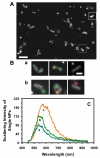Single Nanoparticle Plasmonic Spectroscopy for Study of the Efflux Function of Multidrug ABC Membrane Transporters of Single Live Cells
- PMID: 27570617
- PMCID: PMC4999259
- DOI: 10.1039/C6RA05895G
Single Nanoparticle Plasmonic Spectroscopy for Study of the Efflux Function of Multidrug ABC Membrane Transporters of Single Live Cells
Abstract
ATP-binding cassette (ABC) membrane transporters exist in all living organisms and play key roles in a wide range of cellular and physiological functions. The ABC transporters can selectively extrude a wide variety of structurally and functionally unrelated substrates, leading to multidrug resistance. Despite extensive study, their efflux molecular mechanisms remain elusive. In this study, we synthesized and characterized purified silver nanoparticles (Ag NPs) (97 ± 13 nm in diameter), and used them as photostable optical imaging probes to study efflux kinetics of ABC membrane transporters (BmrA) of single live cells (B. subtillis). The NPs with concentrations up to 3.7 pM were stable (non-aggregated) in a PBS buffer and biocompatible with the cells. We found a high dependence of accumulation of the intracellular NPs in single live cells (WT, Ct-BmrA-EGFP, ΔbmrA) upon the cellular expression level of BmrA and NP concentration (0.93, 1.85 and 3.7 pM), showing the highest accumulation of intracellular NPs in ΔbmrA (deletion of BmrA) and the lowest ones in Ct-BmrA-EGFP (over-expression of BmrA). Interestingly, the accumulation of intracellular NPs in ΔbmrA increases nearly proportionally with the NP concentration, while those in WT and Ct-BrmA-EGFP do not. This suggests that the NPs enter the cells via passive diffusion driven by concentration gradients and are extruded out of cells by BmrA transporters, similar to conventional pump substrates (antibiotics). This study shows that such large substrates (84-100 nm NPs) can enter into the live cells and be extruded out of the cells by BmrA, and the NPs can serve as nm-sized optical imaging probes to study the size-dependent efflux kinetics of membrane transporters in single live cells in real time.
Keywords: ABC (BmrA) transporter; Ag nanoparticle; Bacillus subtilis; multidrug resistance; single cell imaging; single nanoparticle plasmonic spectroscopy.
Figures






Similar articles
-
Single Nanoparticle Plasmonic Spectroscopy for Study of Charge-Dependent Efflux Function of Multidrug ABC Transporters of Single Live Bacillus subtilis Cells.J Phys Chem C Nanomater Interfaces. 2016 Sep 22;120(37):21007-21016. doi: 10.1021/acs.jpcc.6b03313. Epub 2016 May 26. J Phys Chem C Nanomater Interfaces. 2016. PMID: 29662596 Free PMC article.
-
Single gold nanoparticle plasmonic spectroscopy for study of chemical-dependent efflux function of single ABC transporters of single live Bacillus subtilis cells.Analyst. 2018 Mar 26;143(7):1599-1608. doi: 10.1039/c7an01787a. Analyst. 2018. PMID: 29488517 Free PMC article.
-
Probing of multidrug ABC membrane transporters of single living cells using single plasmonic nanoparticle optical probes.Anal Bioanal Chem. 2010 Aug;397(8):3317-28. doi: 10.1007/s00216-010-3864-8. Epub 2010 Jun 11. Anal Bioanal Chem. 2010. PMID: 20544182 Free PMC article.
-
Current Understanding of Interactions between Nanoparticles and ABC Transporters in Cancer Cells.Curr Med Chem. 2018;25(42):5930-5944. doi: 10.2174/0929867325666180314122200. Curr Med Chem. 2018. PMID: 29542407 Review.
-
The role of multidrug resistance efflux transporters in antifolate resistance and folate homeostasis.Drug Resist Updat. 2006 Aug-Oct;9(4-5):227-46. doi: 10.1016/j.drup.2006.09.001. Epub 2006 Nov 7. Drug Resist Updat. 2006. PMID: 17092765 Review.
Cited by
-
Size-Dependent Inhibitory Effects of Antibiotic Nanocarriers on Filamentation of E. coli.Nanoscale Adv. 2020 May 1;2(5):2135-2145. doi: 10.1039/c9na00697d. Epub 2020 Mar 30. Nanoscale Adv. 2020. PMID: 33791510 Free PMC article.
-
Single Nanoparticle Plasmonic Spectroscopy for Study of Charge-Dependent Efflux Function of Multidrug ABC Transporters of Single Live Bacillus subtilis Cells.J Phys Chem C Nanomater Interfaces. 2016 Sep 22;120(37):21007-21016. doi: 10.1021/acs.jpcc.6b03313. Epub 2016 May 26. J Phys Chem C Nanomater Interfaces. 2016. PMID: 29662596 Free PMC article.
-
Single gold nanoparticle plasmonic spectroscopy for study of chemical-dependent efflux function of single ABC transporters of single live Bacillus subtilis cells.Analyst. 2018 Mar 26;143(7):1599-1608. doi: 10.1039/c7an01787a. Analyst. 2018. PMID: 29488517 Free PMC article.
-
Antibiotic Drug Nanocarriers for Probing of Multidrug ABC Membrane Transporter of Bacillus subtilis.ACS Omega. 2020 Jan 13;5(3):1625-1633. doi: 10.1021/acsomega.9b03698. eCollection 2020 Jan 28. ACS Omega. 2020. PMID: 32010837 Free PMC article.
-
Size-Dependent Inhibitory Effects of Antibiotic Drug Nanocarriers against Pseudomonas aeruginosa.ACS Omega. 2018 Jan 31;3(1):1231-1243. doi: 10.1021/acsomega.7b01956. Epub 2018 Jan 30. ACS Omega. 2018. PMID: 29399654 Free PMC article.
References
Grants and funding
LinkOut - more resources
Full Text Sources
Other Literature Sources
Molecular Biology Databases
Miscellaneous
